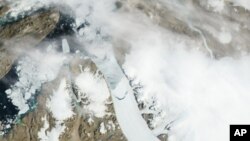A NASA satellite has captured images of a huge iceberg breaking off from one of the largest glaciers in the Arctic territory of Greenland.
The iceberg, which measures twice the size of New York City's Manhattan island (about 120 square kilometers), broke off Greenland's Petermann Glacier earlier this week. Images from NASA's Aqua satellite showed the iceberg separating from a floating river of ice called an ice tongue, which is part of the mostly land-based glacier.
The initial rift in the ice was first detected in 2001.
This is the second time in two years that a massive iceberg has calved, or broken off, from the Petermann Glacier. The iceberg that calved in 2010 was twice the size of the one that broke off this week.
Glaciers calve icebergs normally, but the frequency and size of the icebergs have raised concerns among scientists that climate change is a factor.
Some information for this report was provided by AP, AFP and Reuters.
The iceberg, which measures twice the size of New York City's Manhattan island (about 120 square kilometers), broke off Greenland's Petermann Glacier earlier this week. Images from NASA's Aqua satellite showed the iceberg separating from a floating river of ice called an ice tongue, which is part of the mostly land-based glacier.
The initial rift in the ice was first detected in 2001.
This is the second time in two years that a massive iceberg has calved, or broken off, from the Petermann Glacier. The iceberg that calved in 2010 was twice the size of the one that broke off this week.
Glaciers calve icebergs normally, but the frequency and size of the icebergs have raised concerns among scientists that climate change is a factor.
Some information for this report was provided by AP, AFP and Reuters.
